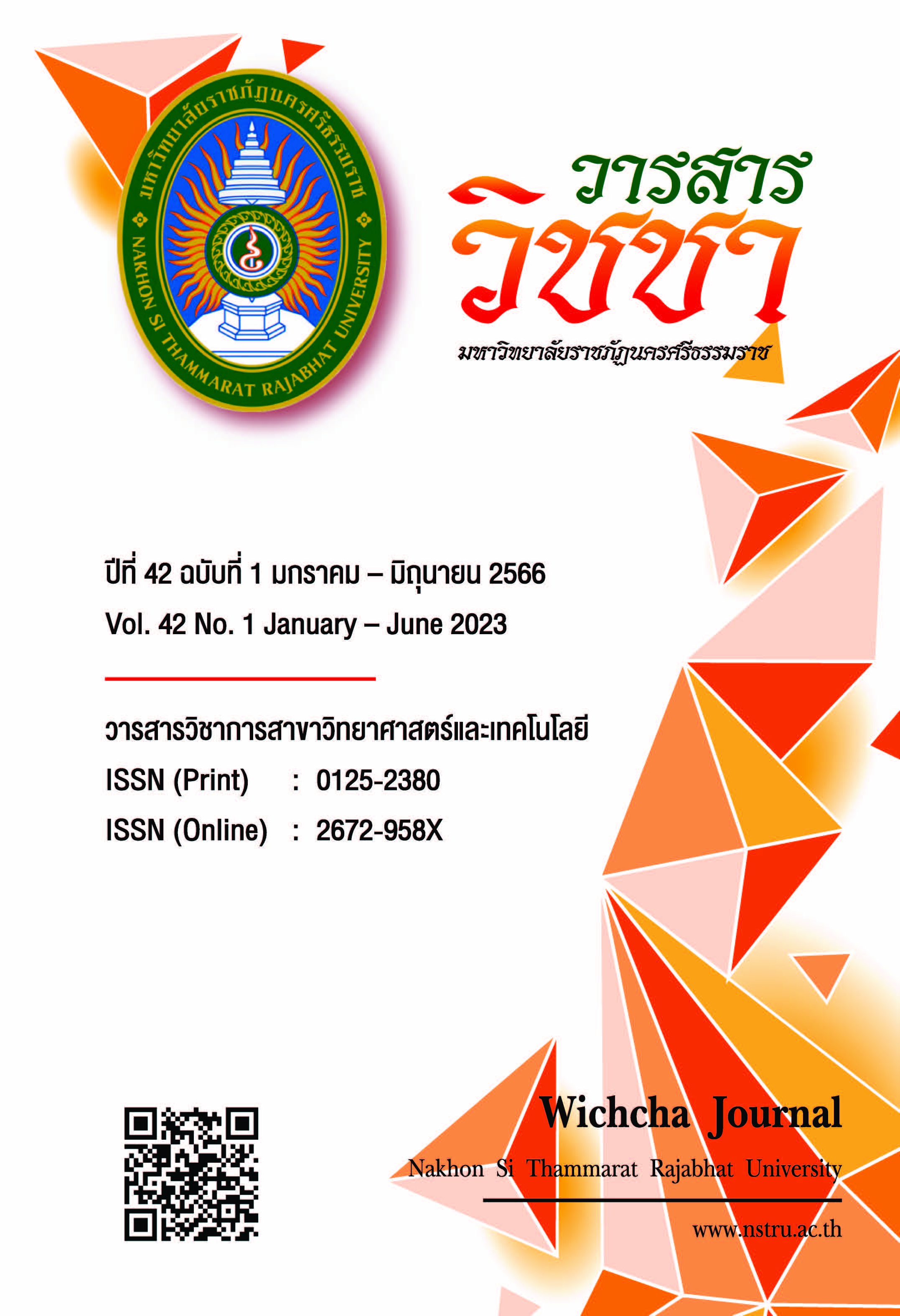The Effect of Light Intensity on the Growth and Carotenoid Production of Chlorococcum sp. TISTR 8266
Main Article Content
Abstract
In this research, the effect of light intensity on the growth and carotenoid production of the green algae Chlorococcum sp. TISTR 8266 was investigated. This microalgae accumulates pigment in the carotenoid group under stress conditions. The pigments in the carotenoid group are qualified as highly effective antioxidants. It can be used as a dietary supplement in both humans and animals and used as cosmetic products. The experimental results showed that the best cultivation condition is Treatment 3 with light intensity of 8,500-9,000 lux, N8 medium and temperature of 28±2°C. The biomass yield of Treatment 3 at day 14, 21 and 28 are 4.30±0.18, 6.13±0.19 and 6.24±0.15 grams per liter, respectively, and the carotenoid content are 2.76±0.26, 3.92±0.18 and 3.89±0.36 milligrams per gram dried weight (g-dw), respectively. These results were significantly different (p < 0.05) when compared to Treatment 1 with the light intensity of 4,000-4,500 lux and Treatment 2 with the light intensity of 7,500-8,000 lux in the same cultivation period. These findings indicated that high light intensity is one of the important factors that has a positive effect on growth and stimulation on algae to produce pigments in the carotenoid group.
Article Details

This work is licensed under a Creative Commons Attribution-NonCommercial-NoDerivatives 4.0 International License.
เนื้อหาและข้อมูลในบทความที่ลงตีพิมพ์ในวารสารวิชชา มหาวิทยาลัยราชภัฏนครศรีธรรมราช ถือเป็นข้อคิดเห็นและความรับผิดชอบของผู้เขียนบทความโดยตรง ซึ่งกองบรรณาธิการวารสารไม่จำเป็นต้องเห็นด้วยหรือร่วมรับผิดชอบใด ๆ
บทความ ข้อมูล เนื้อหา รูปภาพ ฯลฯ ที่ได้รับการตีพิมพ์ในวารสารวิชชา มหาวิทยาลัยราชภัฏนครศรีธรรมราช ถือเป็นลิขสิทธ์ของวารสารวิชชา มหาวิทยาลัยราชภัฏนครศรีธรรมราช หากบุคคลหรือหน่วยงานใดต้องการนำข้อมูลทั้งหมดหรือส่วนหนึ่งส่วนใดไปเผยแพร่ต่อหรือเพื่อการกระทำการใด ๆ จะต้องได้รับอนุญาตเป็นลายลักษณ์อักษรจากวารสารวิชชา มหาวิทยาลัยราชภัฏนครศรีธรรมราชก่อนเท่านั้น
The content and information in the article published in Wichcha journal Nakhon Si Thammarat Rajabhat University, It is the opinion and responsibility of the author of the article. The editorial journals do not need to agree. Or share any responsibility.
References
ฐิรารัตน์ แก้วจำนง สมรักษ์ รอดเจริญ อำนวยโชค เวชกุล ธัชชา สามพิมพ์ การุณ ทองประจุแก้ว นัทท์ นันทพงศ์ มานพ อาดำ และเสาวลักษณ์ มาลาวะ. (2564). ผลของการเสริมสาหร่ายสีเขียวแกมน้ำเงิน Nostoc commune vaucher TISTR 8870 ต่อการเจริญเติบโต ประสิทธิภาพการใช้อาหาร และการสร้างสีของปลากัด (Betta splendens Regan, 1910). วารสารวิชชา มหาวิทยาลัยราชภัฏนครศรีธรรมราช, 40(1), 106-120.
นราทร สุขวิเสส วิมลวรรณ วัฒนวิจิตร ปริชาติ อยู่แพทย์ และสุปรียา ศุขเกษม. (2562). การคัดเลือกสาหร่ายขนาดเล็กที่มีศักยภาพสูงในการผลิตสารสำคัญ และการศึกษาปัจจัยที่เหมาะสมในการกระตุ้นการสะสมสารสำคัญ. รายงานผลการวิจัยเรื่องเต็ม ประจำปี 2562. กองวิจัยและพัฒนาวิทยาการหลังการเก็บเกี่ยวและแปรรูปผลิตผลเกษตร.
Aburai, N., Sumida, D. and Abe, K. (2015). Effect of light level and salinity on the composition and accumulation of free and ester-type carotenoids in the aerial microalga Scenedesmus sp. (Chlorophyceae). Algal Research, 8, 30-36, doi: https://doi.org/10.1016/j.algal.2015.01.005.
Ambati, R.R., Ravi, S. and Aswathanarayana, R.G. (2010). Enhancement of carotenoids in green alga-Botryococcus braunii in various autotrophic media under stress condition. International Journal of Biomedical and Pharmaceutical Sciences, 4(2), 87-92.
Borowitzka, L.J. and Borowitzka, M.A. (1989). β-carotene (pro-vitamin a) production with algae. In Vandamme, J. (Ed.). Biotechnology of vitamins, pigment and growth factors, pp. 15-26, London: Elsevier Applied Science.
Choi, M.H., Kim, G.H. and Lee, H.S. (2002). Effects of ascorbic acid retention on juice color and pigment stability in blood orange (Citrus sinensis) juice during refrigerated storage. Food Research International, 35(8), 753-759, doi: https://doi.org/10.1016/S0963-9969(02)00071-6.
Del Campo, J.A., Garcia-Gonzalez, M. and Guerrero, M.G. (2007). Outdoor cultivation of microalgae for carotenoid production: Current state and perspectives. Applied Microbiology and Biotechnology, 74(6), 1163-1174, doi: https://doi.org/10.1007/s00253-007-0844-9.
Fu, W., Guomundsson, O., Paglia, G., Herjolfsson, G., Andresson, O.S., Palsson, B. and Brynjolfsson, S. (2012). Enhancement of carotenoid biosynthesis in the green microalga Dunaliella salina with light-emitting diodes and adaptive laboratory evolution. Applied Microbiology and Biotechnology, 97(6), 2395-2403, doi: https://doi.org/10.1007/s00253-012-4502-5.
Johnson, E.A. and Schroeder, W.A. (1996). Microbial carotenoids. Advances in Biochemical Engineering/Biotechnology, 53, 119-178, doi: https://doi.org/10.1007/BFb0102327.
Leya, T., Rahn, A., Lutz, C. and Remias, D. (2009). Response of arctic snow and permafrost algae to high light and nitrogen stress by changes in pigment composition and applied aspects for biotechnology. Federation of European Microbiological Societies, 67(3), 432-443, doi: https://doi.org/10.1111/j.1574-6941.2008.0064.x.
Lichtenthaler, H. (1987). Chlorophylls and carotenoids, the pigments of photosynthetic biomembranes. In Douce, R. and Packer, L. (Eds.). Methods Enzymol, pp 350-382. New York: Academic Press inc.
Masojidek, J., Torzillo, G., Koblizek, M., Nidiaci, L., Komenda, J., Lukavska, A. and Sacchi, A. (2000). Changes in chlorophyll fluorescence quenching and pigment composition in the green alga Chlorococcum sp. grown under nitrogen deficiency and salinity stress. Journal of Applied Phycology, 12(3), 417-426, doi: https://doi.org/10.1023/A:1008165900780.
Rao, A.V. and Rao, L.G., (2007). Carotenoids and human health. Pharmacological Research, 55(3), 207-216, doi: https://doi.org/10.1016/j.phrs.2007.01.012.
Ruen-ngam, D. (2017). Optimal condition for cultivation of Scenedesmus armatus cultivation and antioxidant activity of its extract. Journal of Food Technology, Siam University, 12(1), 59-70.
Sakagami, Y., Sumiya, Y. and Komemushi, S. (2010). Research on search of the carotenoid-producing microorganisms in marine area and the improvement of production ratio. Yakugaku Zasshi: Journal of the Pharmaceutical Society of Japan, 130(11), 1445-1451, doi: https://doi.org/10.1248/YAKUSHI.130.1445.
Shaish, A., Ben-Amotz, A. and Avron. M. (1992). Biosynthesis of β-carotene in Dunaliella. Methods in Enzymology, 213, 439-444, doi: https://doi.org/10.1016/0076-6879(92)13145-N.
Sivathanu, B., and Palaniswamy, S. (2012). Purification and characterization of carotenoids from green algae Chlorococcum humicola by HPLC-NMR and LC-MS-APCI. Biomedicine & Preventive Nutrition, 2(4), 276-282, doi: https://doi.org/10.1016/j.bionut.2012.04.006.
Stainer, R.Y., Kunisawa, R., Mandel, M. and Cohen-Bazire, G. (1971). Purification and properties of unicellular blue-green algae (order Chlorococcales). American Society for Microbiology, 35(2), 171-205. doi: https://doi.org/10.1128/br.35.2.171-205.1971.
Takaichi, S. (2011). Carotenoids in algae: Distributions biosynthesis and functions. Marine Drugs, 9(6), 1101-1118, doi: https://doi.org/10.3390/md9061101.
Vonshak, A. (1986). Handbook of microalgae mass culture: Laboratory techniques for the cultivation of microalgae. Florida: CRC Press.
Young, A.J. (1993). Factors that affect the carotenoid composition of higher plants and algae. In Young, A.J. and Britton, G. (Eds.). Carotenoids in Photosynthesis, pp. 160-205. Dordrecht: Springer.
Zhang, D.H. and Lee, Y.K. (1997). Enhanced accumulation of secondary carotenoids in a mutant of the green alga, Chlorococcum sp. Journal of Applied Phycology, 9(5), 459-463. doi: https://doi.org/10.1023/A:1007902103419.
Zheng, S., Yu, Z., Li-ping, S., and Jin, L. (2019). Light elicits astaxanthin biosysnthesis and accumulation in the fermented ultrahigh-density Chlorella zofinginesis. Journal of Agricultural and Food Chemistry, 67(19), 5579-5586, doi: https://doi.org/10.1021/acs.jafc.9b01176.


